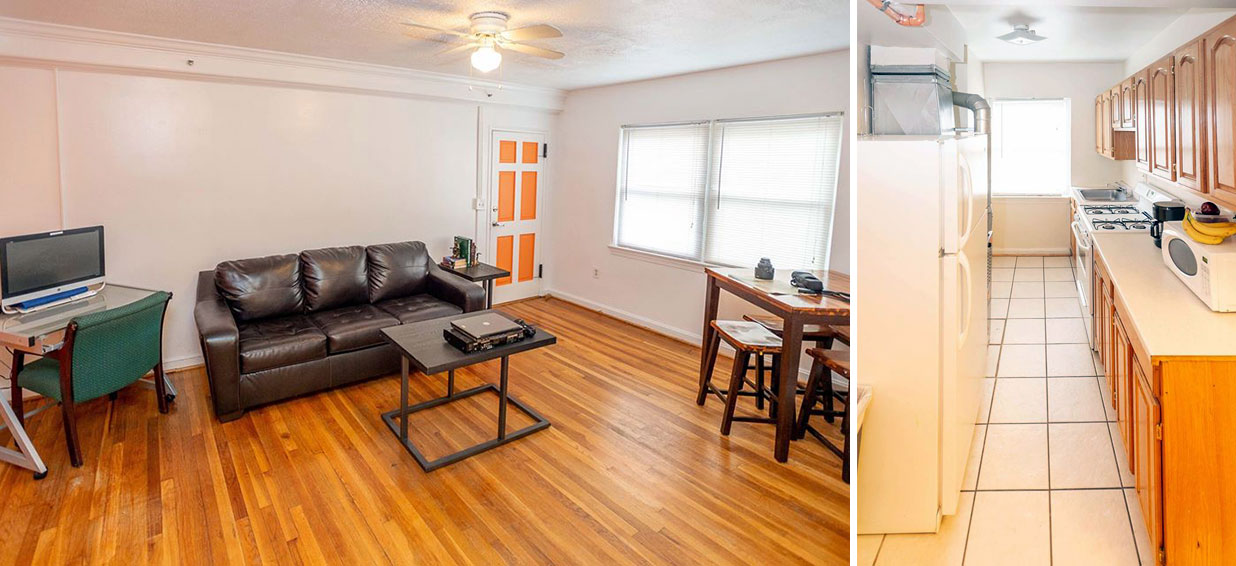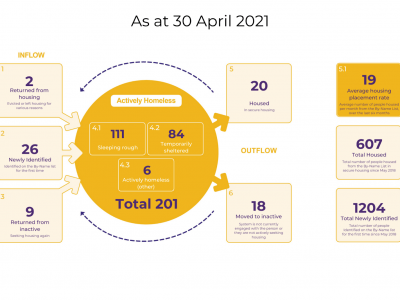A few years ago, the Chesapeake Health Education Program, Inc. — otherwise known as CHEP — decided to undergo an organizational rebrand that included a reevaluation of its mission statement. In addition to educational programs and conference and event services, CHEP has provided transitional housing for veterans since 2012.
Leaders of the organization wanted to ensure that any revised mission statement would emphasize their primary focus — helping veterans by providing housing and services.
Over the last year, however, CHEP has redoubled that commitment to its mission by converting their transitional, or temporary, housing for veterans in D.C. into permanent housing, allowing them to help even more veterans exit homelessness and quickly achieve housing stability. They converted their 14 transitional beds into eight permanent units — fully-furnished one-bedroom apartments available at an affordable, below-market rate to veterans exiting homelessness.
Repurposing their transitional housing program and property combined the evolving needs of the veterans CHEP serves and those of D.C. at large. As part of the Built for Zero movement, Washington, D.C. is dedicated to reducing veteran homelessness toward functional zero — a dynamic, measurable end state where veteran homelessness is rare and brief. Since working with Built for Zero, the community has decreased veteran homelessness by nearly 50% and are working toward reaching functional zero in the coming years.
CHEP CEO Cathy Bennett knew the process of conversion would be a challenge, but one they could meet. “You need to think about how you can expand your services — because that’s basically what this is — and still remain true to your mission. And this is a mechanism to do that.”

Understanding the conversion opportunity
Located in the Anacostia neighborhood of Washington, D.C., the CHEP building had been offering transitional housing for the past ten years as a Grant and Per Diem (GPD) provider. The GPD program, administered by the U.S. Department of Veteran Affairs, provides service-intensive transitional housing programs for veterans by funding facilities on a per-diem basis.
As communities reduce veteran homelessness, some have found that getting to functional zero would be supported by having fewer transitional beds and more permanent units. By taking the GPD beds “offline” and increasing the supply of permanent housing, more veterans experiencing homelessness can be permanently housed, contributing to a reduction in homelessness on the way to reaching functional zero.
While official plans for converting CHEP D.C. to permanent housing began in 2021, Housing Manager Michael Strong and CEO Cathy Bennett had been in conversation about it for some time. Strong explained he was “delighted” when approached with the idea of converting from transitional housing.
“We saw how the landscape was changing and saw that permanent housing would be where everyone was going to go,” he said. “It’s been a learning process since we started this process in August of last year. But it’s well worth it.”
The CHEP D.C. property consists of eight one-bedroom units of roughly 800 square feet. When operating as GPD beds, each unit held two residents needing temporary supportive housing. Upon conversion to permanent housing, the units became single occupancy permanent housing, and each resident is required to pay the rent, whether via a subsidy or voucher or their own income.
Kaiser Permanente supported this conversion with $250,000 in grant funding awarded to The Community Partnership for the Prevention of Homelessness and subcontracted to CHEP. These dollars have gone toward supporting operational needs during the first year of conversion, such as staffing, maintenance, and repairs.
Aligning with the mission and needs
Converting the CHEP D.C. building to permanent housing allows the organization to offer several new benefits to the veterans they serve. As one of the most expensive housing markets in the U.S., Washington, D.C. has a dearth of affordable housing options.
“We’re providing eight units that are affordable. $1,279 a month in Washington, D.C. — for a one-bedroom apartment, utilities, laundry on-site, free Wifi, hardwood floors,” Strong said. “It’s unheard of.”

“We’re providing eight units that are affordable. $1,279 a month in Washington, D.C. — for a one-bedroom apartment, utilities, laundry on-site, free Wifi, hardwood floors. It’s unheard of.”
—Michael Strong, Housing Manager
The results of the conversion project also allow for the veteran tenants to focus on living on their own. “Affordable housing and a healthy environment are what makes CHEP go here in Washington, D.C.,” Strong said. “We’re staying with our mission — it’s all about the veteran.”
Alongside the physical changes to the CHEP building came necessary philosophical shifts to this new model.
“From a programmatic standpoint, it was really a struggle for us, because to some degree we felt like we were giving up some control,” Bennett explained. “We worried it would impact our core mission which was really to serve veterans.”
One way they had to adapt was by starting to operate under a Housing-First-focused model. The Housing First approach prioritizes giving people permanent housing, without preconditions, like mandatory treatment programs, sobriety, or other services. This approach highlights the need for stable, secure housing above all, while offering voluntary supportive services.
“If you understand Housing First, then the transition becomes easier to understand and easier to accept,” Strong noted.
He knows that for a veteran with lived experience of homelessness, living in CHEP D.C. may be a waypoint on a longer journey. “Even if the veteran only stays a year, what that one year has done is give that veteran a sense of independence. And coming from a case manager perspective, that’s what we want. We want the veteran to continue to grow.”
Additionally, the transition to permanent housing was eased by the recognition that CHEP D.C. could meet an important need, while still serving as an integral part of their homeless response system.
“We knew that we were going to help fill a void in the Continuum of Care by having permanent housing,” Bennett said. “We have to figure out how to make ourselves fit in that space.”
Assisting CHEP D.C. as they acclimate to this space is Jaydot, an organization that helps develop and operate affordable housing with a focus on projects that will help end homelessness in the Washington, D.C. area. Jaydot has lent valuable expertise throughout the conversion to permanent housing, helping the CHEP team navigate the many nuances of being a landlord and maintaining fidelity to the Housing First model. Jaydot’s support for the project has been funded by The Home Depot Foundation as part of their broader support for Built for Zero.
“Thankfully, the number of veterans experiencing homelessness in D.C. is declining, which means we have more of a need for permanent housing and less of a need for shelter and transitional housing,” commented Sharlene Castle, Director of Operations at Jaydot.
“CHEP has built such a positive reputation for themselves within D.C., and they have so much expertise in serving veterans. It’s been great to see them proactively and happily moving forward. This has been an opportunity for them to not only stay aligned with their mission of helping veterans, but to also align with the community’s needs — by housing more veterans.”

Developing partnerships to support tenants and manage the property
Having a foundation of community and organizational relationships and building upon them has been important throughout this conversion process. Michael Strong, as a former case manager, has been a central player. He adopts a collaborative approach to the work, making a point to get out and know the local D.C. neighborhood and residents.
“The community here knows who we are. They respect us,” he said. “It’s because of the relationship that we built with the community.”
Along with bolstering community relationships, Strong firmly believes in the necessity of working with other like-minded organizations. For example, CHEP signed an MOU with US Vets to be able to continue offering supportive services to their veteran tenants, if they want them.
He also has had discussions with other local permanent housing providers, like Access Housing, to find out about local maintenance resources. “Sometimes my electrician or my plumber wasn’t available,” he said. “Then I could reach out to those guys and we could get the project finished that way.”
Similarly, Strong continues to foster a relationship with government agencies.
“I believe that communication with the VA is still important — it has been a huge help to me as a landlord,” he said. If a veteran tenant cannot make rent for one month, for instance, Strong has been able to connect with the VA to find a solution, while relying on those supportive services still available to the tenants.
Strong also participated in a training with the D.C. Housing Authority to learn about all of the moving parts of the housing process directly from housing specialists and inspectors. He wanted to be able to understand what they were looking for and what they needed as they brought in permanent housing tenants.
Bennett has been proud of her colleague and his dedicated approach: “Michael really forged the way because of the network that he already had in place. He was able to develop and foster that sense of trust and understanding that, at the end of the day, everybody’s on the same team.”
“As of May 2022, DC has achieved a 47% reduction in veteran homelessness since 2017, and we hope to reach functional zero for veterans by the end of 2024 as part of the Large City Last Mile Initiative under Built for Zero.”
Theresa Silla, Executive Director of the ICH
Another key player on the team has been the Interagency Council on Homelessness (ICH), which is the public-private partnership responsible for developing and implementing Homeward DC 2.0, the District’s Strategic Plan for ending and preventing homelessness. ICH keenly understands the need for creating affordable housing dedicated to people experiencing homelessness.
“We applaud CHEP’s vision and work to convert transitional housing into permanent affordable housing for veterans. This is an important signal that our system is turning the corner and ready to tackle the last leg on the journey from managing homelessness to ending homelessness,” said Theresa Silla, Executive Director of the ICH.
“As of May 2022, DC has achieved a 47% reduction in veteran homelessness since 2017, and we hope to reach functional zero for veterans by the end of 2024 as part of the Large City Last Mile Initiative under Built for Zero,” Silla added.
Next steps, next year
Leaders at CHEP. are proud of what they have accomplished over the last couple of years, especially because this new program and conversion was launched during a pandemic.
Looking into the new year, Bennett wants to focus on maintaining stability with the changes that have come with converting to permanent housing at the CHEP D.C. property, which includes working with a management company for the building’s operations.
“There are still a lot of unknowns for us,” she said. “So it’s continuing to grow and to learn how to best manage and serve that population that will be residing in that building.”
As for others considering converting their properties to permanent housing, Strong advises to first take a look at your organization’s mission: “What is it you’re doing? Does it all serve your mission? If it still serves your mission, go for it. Stay within your mission.”




